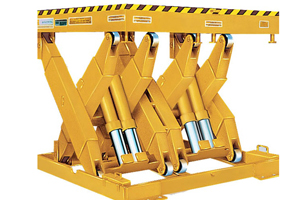Technically, systems that use liquid as a fluid for pressure are called hydraulic systems, and systems using compressed air are called pneumatic systems. Hydraulic systemsis preferred in areas where large forces are required and power is prioritized. Pneumatic systems however, it is preferred in areas where small forces are sufficient, whereas fast operation is important.
In hydraulic systems, the pressure obtained by the compressed liquid is converted into mechanical motion, whereas in pneumatic systems, the gas pressure is converted into mechanical motion.
Based on these definitions, hydraulic lift platformsThe power of the compressed liquid is utilized. In contrast, the stored energy as compressed air is used in pneumatic load lifting platforms. Pneumatic lifting platforms The required air pressure for the air is supplied from a compressor. Compressors are tools that compress the air and store it in a strong steel tank.
Every point where the pressure is actually creates a risk. Leakage of the compressed liquid or air means the discharge of the load in an instant. This is a great danger for the maintenance of workers and the loads they carry. Based on this fact, the Ministry of Labor and Social Security has issued the Regulation on Health and Safety Conditions in the Use of Work Equipment. Annex 3 Maintenance, Repair and Periodic Inspection Issues, Annex, hydraulic and pneumatic lifting platforms, Lifting and forwarding tools showed in the group. As with all other equipment in this group, hydraulic and pneumatic lifting platforms should be periodically inspected and inspected at least once a year.
In addition, these controls and inspections must be carried out by authorized persons. Controls and reports issued by mechanical engineers, mechanical technicians or high technicians as described in the Regulation shall not be deemed valid.
Before the controls to be carried out, reports of the previously conducted controls are requested and if there are any nonconformities detected, it is checked whether they have been removed or not. The static and dynamic controls of the hydraulic and pneumatic lifting platforms, the loaded and unloaded performance controls and a series of inspection and control operations are then carried out.
The Regulation also lists the standards to be considered during these checks as follows:
- TS 10116
- TS EN 280
- TS EN 818-6 + A1
- TS EN 1495 + A2
- TS EN 1709
- TS EN 12079-3
- TS EN 12927-7
- TS EN 13157 + A1
- TS EN ISO 13534
- TS ISO 789-2
- TS ISO 3056
- TS ISO 4309
- TS ISO 7592
- TS ISO 9927-1
- TS ISO 11662-1
- TS ISO 12480-1
- TS ISO 12482-1
- FEM 9.751
- FEM 9.752
- FEM 9.755
- FEM 9.756
The TÜRCERT certification body provides conformity assessment, certification and training services, while providing testing and inspection services. Do not hesitate to contact the experienced managers and employees of the TÜRCERT certification body for further information and inspection of hydraulic and pneumatic lifting platforms.

